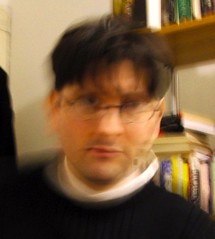Travels in Hyperreality

This photo, taken on the observation deck of the Empire State Building, is from a day spent in NYC with Craig and a friend from Princeton, Geoff Ng, in the Summer of 1992 -- very near the end of my time in The City. Geoff took the photo. I think I first met Geoff in Charles Bernstein's poetry workshop at Princeton during my senior year. Or he may also have been in Chase Twichell's workshop the previous year.
That day, Craig, Geoff, and I checked out the Guinness Book of World Records Museum, located in the basement of the Empire State Building. We perceived and interpreted the objects in the exhibit in light of Umberto Eco's Travels in Hyperreality, for us a recent and exciting discovery. After musing over the delightfully phony but musty photos, dioramas, and videos of such curiosities as Robert Waldrop (eight feet eleven inches at the age of twenty-two) and that dapper, attention-getting man-about-town who affected a "beard of bees," we took the elevator up to the observation deck of the building, where I think this photo was taken. It depicts a moment of verbal improvisation of the kind that was a constant game between Craig and me -- in part a way of joking around, in part a way of generating useful creative sparks that could be captured, fixed, and later rekindled and fanned into life -- notice Craig's handheld tape recorder. We used to carry the handheld recorders everywhere, joke, talk, and sing into them constantly, and use them to grab any ambient noise or audible culture that caught our attention. This eventually led to the accumulation of hundreds of log tapes. This photo, however, is a staged simulation of inspiration (note my self-conscious smile), a representation of the general category, rather than an actual spontaneous moment caught on film.
Later that afternoon we were wandering around the neighborhood in Manhattan where the Museum of Holography -- to which Eco refers in his book -- was supposed to be located, but we never found it. Only later did we discover that the museum had gone out of business and that the collection, including what had long been billed as the largest hologram in the world -- a three-dimensional likeness of the inventor of holography, the Hungarian-born physicist Dennis Gabor, sitting at his desk -- had been sold. It was perhaps two years later that Craig discovered that the collection had been bought by the MIT Museum; he left a message on my answering machine to tell me that the Museum of Holography had followed me up to Cambridge. Eventually we succeeded in finding it at the MIT Museum on an expedition with Lana. The rooms of the gallery were shadowy, illuminated only by the sickly, monochromatic green and red lasers required to reconstitute the recorded images. To my satisfaction, the hologram of Gabor was on display, along with such expressions as a holographic likeness of the smiling face of a woman that transformed itself into the face of a fierce Tiger as one passed from left to right in front of the plate.

I later glowingly (and smugly I know) pronounced the exhibit to be "the greatest collection of holographic kitsch in the world."

